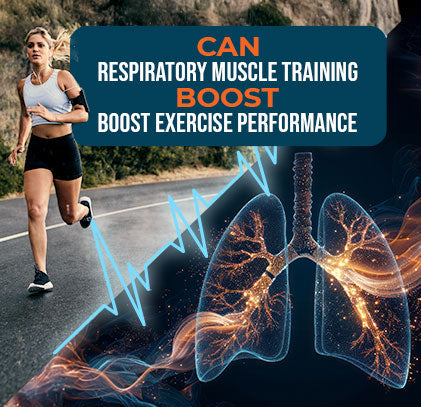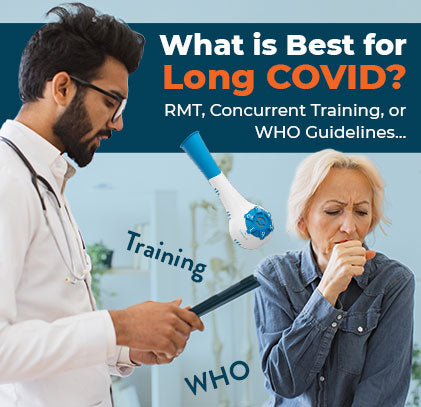Have you ever felt out of breath during a workout, even when your muscles felt strong enough to keep going? When you think of improving exercise performance, you often focus on building stronger muscles, increasing endurance, or perfecting the technique. However, an important factor that you may be missing is your “Breathing”.The way you breathe plays a crucial role in your endurance and overall exercise performance.
THE BREATHER is the cRMT device that trains your inspiratory and expiratory muscles at the same time.
Respiratory muscle training (RMT) is gaining attention as a science-backed tool to enhance fitness by strengthening the muscles responsible for breathing. RMT combines two training modalities: inspiratory muscle training (IMT), which trains your inspiratory muscles, and expiratory muscle training (EMT), which trains your expiratory muscles.
If you perform both of them at the same time, it is called combined respiratory muscle training (cRMT). By strengthening the breathing muscles, RMT can help you breathe easier, perform better, and even recover faster.
The question is, can RMT really improve exercise performance? A study published in “Sports Medicine” explored this question, revealing the surprising benefits of RMT for healthy individuals [1]. Let’s dive into the details and learn how training your breathing with THE BREATHER could give you an edge in your workouts.


What is respiratory muscle fatigue?
Before going into the details, let's learn about respiratory muscle fatigue. It occurs when your breathing muscles (diaphragm and intercostal muscles) become tired and lose their ability to generate force efficiently or sustain contraction. There are many causes for this fatigue; however, the most pronounced reason is insufficient respiratory muscle strength. [2]
During high-intensity workouts, the respiratory muscles must work harder to meet the body’s oxygen demands. However, if these muscles are weak or not trained properly, they fatigue more quickly, thus limiting overall physical performance.
RMT on respiratory muscle fatigue?
RMT is a targeted method to strengthen the breathing muscles, similar to how strength training builds other muscle groups. It involves using some resistance-based devices, such as THE BREATHER, which provides resistance during inhalation and exhalation. RMT strengthens the breathing muscles, enhancing their endurance and recovery and ultimately assisting in delaying breathing muscle fatigue.


Why is breathing strength important for exercise?
Breathing is not just getting in oxygen and letting out carbon dioxide — it is a process everyone should pay attention to. Almost all of us focus on strengthening the peripheral muscle groups and overlook the importance of breathing strength.
The fact is that strong respiratory muscles eventually contribute to reduced exertion, increased exercise recovery, and enhanced oxygen supply to the body, all of which are key factors in increasing exercise performance.
What does scientific research say about RMT and exercise performance?
Researchers from the University of Zurich, Switzerland, conducted a systematic review to assess how respiratory muscle training affects endurance performance in healthy individuals. For that study, the researchers screened 7358 studies and selected 49 studies to include in this review.
They assessed the effect of respiratory muscle training on the performance of healthy individuals and also assessed which training is best for them.
The benefits of RMT for healthy individuals: based on this meta-analysis
The researchers found promising facts about respiratory muscle training in healthy individuals. Let’s break them down and look at them in detail.
RMT and exercise performance
The analysis of 8 studies showed that exercise performance was significantly improved after respiratory muscle training. RMT strengthens the breathing muscles and increases their endurance, thus decreasing the time to fatigue. This all translates to better stamina.
What is better: cRMT or regular RMT?
This study analyzed whether inspiratory muscle training, expiratory muscle training, or combined respiratory muscle training is better for improving fitness in healthy persons. The results showed that IMT and EMT produced similar effects in fitness improvement, however, cRMT was found to be superior to both of these training methods in improving performance.
RMT in less fit healthy individuals vs trained athletes
The analysis of 46 studies showed that less fit but healthy individuals benefited more from RMT than the highly fit athletes. The less fit individuals’ relatively weak breathing muscles can explain this difference. Other than that, less fit individuals have more potential to increase their physical fitness as compared to highly trained and fit athletes.


How does THE BREATHER lead the way in cRMT?
THE BREATHER is the world’s first device designed specifically for cRMT, meaning this single device strengthens both your inspiratory and expiratory muscles simultaneously. This dual-action approach makes your breathing more powerful and efficient so that you can get the maximum out of your breathing training. Backed by clinical research and trusted by athletes, therapists, and everyday users, THE BREATHER stands out as the gold standard in breathing training.
How to incorporate RMT into your routine?
Adding RMT to your training routine is simple and requires just a few minutes daily. Here's how to do it.
-
To train your breathing muscles effectively, select a suitable RMT device like THE BREATHER, which provides adjustable resistance for both inhalation and exhalation.
-
Begin with 5-10 minutes daily, choosing low resistance initially to optimize technique, then gradually increase as your breathing muscles get stronger.
-
Consistency is the key to seeing results with RMT, so keep training for at least 6 days per week for 4-8 weeks.
-
For optimal results, use the free Breather Coach App, which provides tailored training protocols and many bonus strategies and tips.
Conclusions: RMT and Exercise Performance
The evidence is clear that RMT is the game changer for exercise performance, as it can significantly boost performance in healthy individuals. Most importantly, training your inspiratory and expiratory muscles together has a superior impact than training only one of the two. Additionally, healthy but less fit individuals gain more benefits from RMT than trained athletes.










